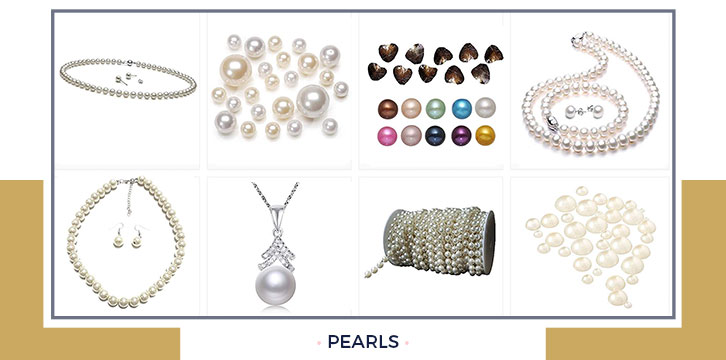Pearl origins
A pearl is one of the only gems to come from a living organism, making them very valuable. There’s a reason the phrase “like pearls before swine” exists – pearls were at one time so incredibly rare that only the nobility or the extremely wealthy could afford to have them. Pearls are most often made by mollusks such as oysters but they may also be found in snails, conchs, and other organisms. The process is generally the same – however, some organisms produce pearls that aren’t made of nacre. (I’ll explain nacre in a minute)
Basically, a small irritant gets into the mollusk’s mantle. It could be as small or smaller than a single grain of sand, but the mollusk will attempt to “quarantine” the irritant by covering it with nacre. Nacre, also called the mother of pearl, is the substance that lines the inside of its shell. Over time, layers upon layers of nacre form around the foreign object, forming a pearl. This doesn’t happen very often – in fact, only one in ten thousand oysters ever produces a pearl naturally – and marketable pearls (round, with good luster and surface quality) are even rarer and valuable. You may be wondering why, if that is the case, are there so many pearls on the market? The reason all comes down to cultivation methods that make mass production possible. Most of the pearls you will find these days are cultured and without that process, your pearl necklace would most likely not exist.
Cultured pearls and cultivation methods
Freshwater and saltwater pearls have different methods but they both result in a process that artificially stimulates the same process that would occur naturally. This means that they are all natural pearls (versus fake, faux, simulated, etc.) but they are less valuable because there are so many on the market. Let’s take a quick look at the different methods for each.
Saltwater pearls use what is called ‘bead nucleation.’ A bead, piece of shell, or other small round object is inserted into the oyster’s mantle. The oyster then, as in nature, forms layers of nacre around the nucleated object. Because round beads are often used, saltwater pearls are more likely to be spherical than freshwater. However, each oyster only produces one pearl and depending on the species, survival rates can be low.
Freshwater pearls, on the other hand, use a small piece of mantle tissue to begin the pearl formation process. As above, the mantle is inserted in the oyster, then harvested at a later date. Freshwater oysters tend to produce as many as twenty pearls from one oyster! Furthermore, the water can be irradiated to change the color very easily. Their quality is more or less equivalent to saltwater with a slight tendency to irregularity in shape.
Types of Pearls
There are a few main types of pearls on the market. These are mostly named according to a region, though in general, you may see references to freshwater or saltwater, which I have covered above.
Akoya: These are high-quality Japanese (or Chinese) saltwater pearls. They tend to be smaller than some of the other varieties but make up for it with their extremely high quality. Colors tend to be white with rose, ivory, cream, or silver overtones, making them one of the best choices for a classic pearl necklace.
Tahitian: The name is misleading as there are no pearl farms actually located in Tahiti. Instead, pearls are harvested from all over French Polynesia. These are known for their intense, dark, often metallic colors. The black-lipped oyster which produces these pearls is the only one in the world to produce a true black. Other colors include peacock, pistachio, blue, brown, grey, and aubergine.
South Sea: South Sea Pearls are produced in the area between Australia and China. Known for their rich, warm, colors (most often gold), South Sea pearls are also among the largest on the market. Their average size is 13mm though they may also produce pearls as large as 20mm. (For reference, the average pearl size in a necklace is 7-8mm.) These pearls also have a very thick nacre, making them extremely beautiful as well as very durable.
Cortez: In the 1500s, the Gulf of California was known as the sea of pearls, and the pearls harvested from the region were in high demand. However, due to over-fishing the Panama black-lipped and rainbow-lipped oysters were hunted nearly to extinction. Nowadays the only marine cultured pearl farm is located there. They are known for their intense colors and are the only pearls qualified for the “Fair Trade Gems” protocols.
Conch Pearls: These pearls are not actually made of nacre, but are highly valued. They are produced by the Queen Conch mollusk which lives in the Caribbean. Since they cannot be cultured (yet) conch pearls are found very rarely. They are known for their pink colors and unique “flame” pattern.
Melo Melo Pearls: Like the conch above, these are also non-nacreous. They come from a marine snail called the Melo Melo, which lives in the South China Sea. Again, these are very rare because there is no known cultivation method. Melo Melo pearls are best known for their size (very large) and shape (very round). The most valuable color is orange.
Abalone Pearls: These natural pearls are found in the Haliotis abalone (also called the paua by New Zealanders.) Though they can be cultured, it is a very difficult process – abalone are hemophiliacs! One single nick while nucleating could kill them. For that reason, only mabe pearls can be produced successfully. A beautiful iridescent blue is the most common color and they are popular in New Zealand and Australia, though not yet in the Western Hemisphere.
Scallop Pearls: Like the conch and Melo Melo, these are not made of nacre but are produced by a similar process. They are found in the “Pacific Lion’s Paw” mollusk which lives in the waters around North and Central America. Scallop pearls are often maroon, plum, orange, and pink, and are very rare.
Though I have listed many different types, the most common are freshwater (usually from China), Akoya, Tahitian, and South Sea.


